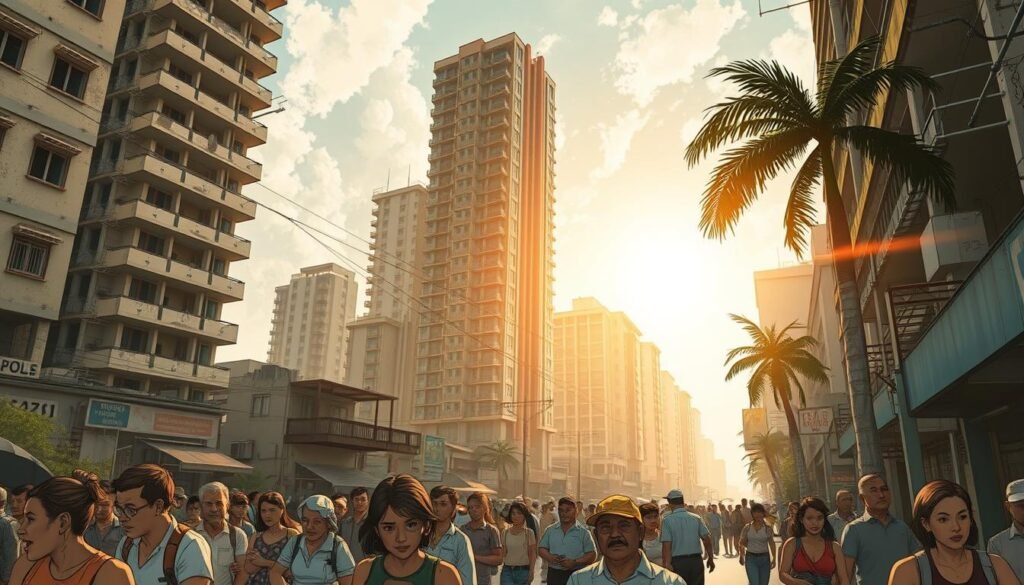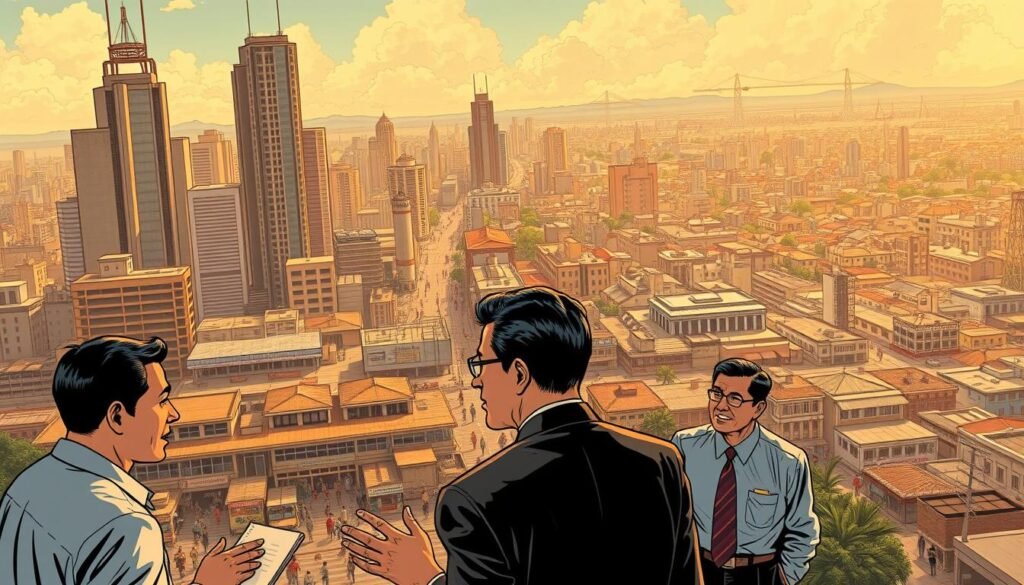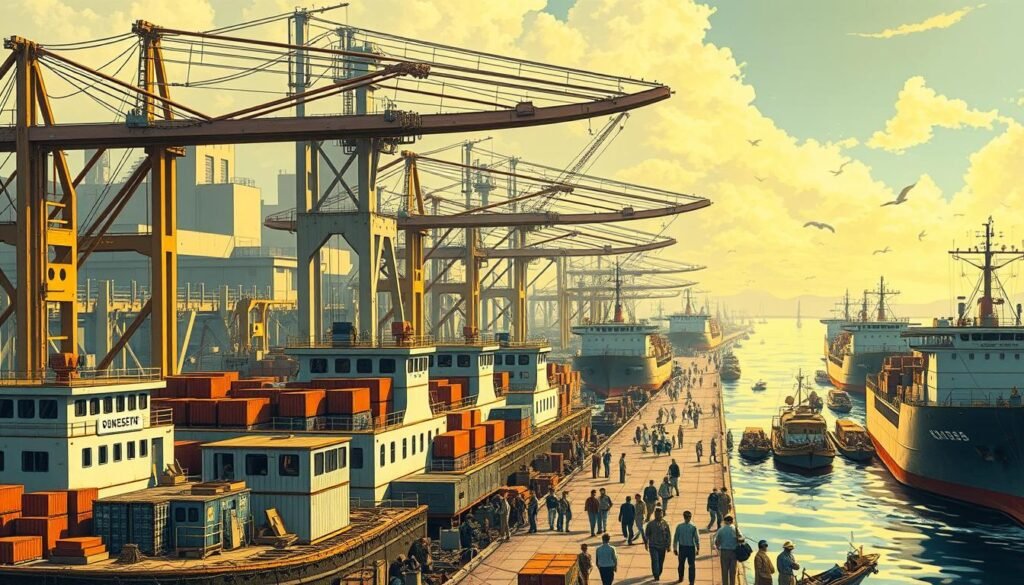The 1950s marked a pivotal era for the Philippines as the country emerged from the shadows of World War II. This decade saw a remarkable transformation, driven by increased production and renewed growth. The nation began to rebuild its industries, setting the stage for a brighter future.
Key indicators, such as GDP per capita, reflected significant progress. Trade flourished, and consumer activity surged, signaling a revitalized market. Government policy played a crucial role, fostering stability and encouraging investment.
Technological advancements and international partnerships further fueled this upward trajectory. The Philippines was no longer just recovering; it was thriving. This period laid the foundation for the country’s modern economic landscape.
Key Takeaways
- The 1950s were a transformative period for the Philippines.
- Increased production and GDP per capita highlighted economic progress.
- Trade and consumer activity saw significant growth.
- Government policies supported stability and investment.
- Technological advancements and international trade played key roles.
Historical Context of Post-War Philippines
The aftermath of World War II brought profound changes to the Philippines, reshaping its society and governance. The war left the country in ruins, with over 1 million lives lost and infrastructure destroyed. However, this period also became a catalyst for significant social and political reforms.

Social and Political Reformation after World War II
Following the war, the Philippines underwent extensive social and political restructuring. The government focused on rebuilding institutions and addressing land reform. Schools reopened, and efforts were made to restore trade and production.
The Philippine Commonwealth, established in 1935, played a pivotal role in this transition. The Tydings-McDuffie Law paved the way for independence in 1946, marking a new era of self-governance. The state also prioritized reopening schools and restoring market stability.
Global Economic Influences on Recovery
The Philippines’ recovery was heavily influenced by global economic trends. The United States provided significant aid, including the Rehabilitation Bill, which allocated $620 million for rebuilding. This support helped stabilize the nation and foster growth.
International partnerships, particularly with the U.S. and Europe, played a crucial role. The Bell Trade Bill extended free trade relations, boosting consumer activity and development. These external factors, combined with domestic policy changes, laid the foundation for a resilient economy.
- Post-war reforms focused on rebuilding institutions and addressing land reform.
- Global aid, particularly from the U.S., played a key role in stabilizing the Philippines.
- International trade agreements boosted economic recovery and growth.
Sectoral Growth and Economic Transformation
The 1950s ushered in a new chapter for the Philippines, marked by rapid progress and modernization. This period saw significant advancements in key sectors, driving the nation’s economic transformation. Agriculture and manufacturing emerged as pillars of growth, reshaping the country’s industrial landscape.
Agricultural Advancements in the 1950s
Agriculture played a central role in the Philippines’ post-war recovery. The 1950s witnessed the adoption of modern farming techniques, boosting production and meeting rising consumer demands. Innovations such as irrigation systems and high-yield crop varieties transformed traditional practices.
Government policy also supported this sector, with initiatives aimed at improving land distribution and access to resources. These efforts not only increased agricultural output but also created more jobs, benefiting rural communities.

Manufacturing and Trade Expansion
The manufacturing sector experienced a surge in activity during the 1950s. Factories adopted advanced technologies, enhancing production efficiency and product quality. This shift was driven by both domestic demand and international trade opportunities.
Local industries began exporting goods, strengthening the country’s position in the global market. Key products like textiles and processed foods gained popularity, contributing to overall GDP growth. The interplay between domestic and international forces fueled this sector’s expansion.
| Sector | Key Developments | Impact |
|---|---|---|
| Agriculture | Modern farming techniques, irrigation systems | Increased production, job creation |
| Manufacturing | Technological adoption, export growth | Enhanced efficiency, GDP contribution |
The 1950s laid the foundation for a diversified and resilient economy. By modernizing agriculture and expanding manufacturing, the Philippines achieved sustained growth. These sectoral advancements not only improved living standards but also positioned the country for future development.
For more insights into the Philippines’ historical progress, explore this detailed analysis.
Government Policy Shaping the Philippine Economy
The 1950s saw the Philippine government take bold steps to reshape its economic landscape. Through strategic fiscal reforms and targeted stimulus measures, the nation achieved remarkable recovery and growth. These policies not only stabilized the market but also laid the foundation for long-term prosperity.

Fiscal Reforms and Stimulus Measures
During this period, the government introduced key reforms to address post-war challenges. Initiatives like land redistribution and tax adjustments boosted production and encouraged investment. These measures were designed to create a balanced economic environment, fostering both domestic and international trade.
Collaboration with institutions like the World Bank played a crucial role. Financial aid and technical expertise helped implement effective policies. This partnership ensured that the Philippines could navigate global uncertainties while maintaining steady growth.
- Land reforms improved resource distribution and increased agricultural output.
- Tax policies encouraged business investment and consumer spending.
- Regulatory frameworks moderated inflation and stabilized prices.
- International partnerships expanded trade opportunities and boosted exports.
These efforts not only revitalized the nation but also enhanced its competitiveness on the global stage. The 1950s remain a testament to the power of well-crafted government policy in driving sustainable development.
Inflation, Price Stability, and Market Dynamics
Balancing economic expansion with price stability became a critical focus for the Philippines in the 1950s. As the country experienced rapid growth, managing inflation emerged as a persistent challenge. Rising prices threatened to undermine consumer confidence and disrupt trade and production.

To address this, the government implemented targeted policy measures. Interest rate adjustments were used to moderate rising prices, ensuring that demand remained steady without overheating the market. These interventions were crucial in maintaining a balance between growth and stability.
Managing Inflation Amidst Rapid Growth
Historical data shows that inflation peaked during periods of rapid economic expansion. For example, in the U.S., inflation reached 9.1% in June 2022, the highest level since 1982. Similarly, the Philippines faced similar pressures during its post-war recovery.
To combat this, the Bangko Sentral ng Pilipinas (BSP) adopted an inflation targeting framework in 2002. This approach aimed to keep inflation low and stable, fostering sustainable growth. By focusing on price stability, the BSP helped preserve consumer confidence and economic balance.
- Interest rate adjustments were key tools in moderating inflation.
- Policy interventions ensured steady demand without market overheating.
- Inflation targeting frameworks promoted long-term economic stability.
Global influences also played a role. The U.S. and other international partners provided support, helping the Philippines navigate inflationary pressures. This collaboration underscored the importance of global trade and partnerships in maintaining domestic stability.
For more insights into managing inflation, explore this detailed analysis.
In conclusion, the Philippines’ ability to manage inflation during the 1950s was a testament to effective policy and international cooperation. These efforts laid the groundwork for sustained growth and long-term economic development.
International Trade and External Contributions
International partnerships became a cornerstone of the Philippines’ economic strategy in the 1950s. The country actively engaged in bilateral trade agreements, fostering relationships with key global partners. These collaborations not only boosted trade but also introduced advanced technologies and practices that transformed local industries.

Bilateral Trade with Key Global Partners
The Philippines strengthened its ties with the U.S., Europe, and other nations during this period. Trade agreements like the Bell Trade Act facilitated the exchange of goods, enhancing market access for Philippine products. This led to increased exports of textiles, processed foods, and agricultural goods, driving economic growth.
Foreign investments also played a significant role. Partnerships with international businesses brought capital and expertise, modernizing local production methods. These collaborations helped the Philippines compete on a global scale, creating new opportunities for innovation and development.
Impact of Foreign Investment and World Bank Policies
The World Bank was instrumental in supporting the Philippines’ economic reforms. Through financial aid and technical assistance, the Bank helped implement policies that stabilized the market and encouraged investment. Projects focused on infrastructure and industrial development laid the foundation for sustained growth.
Global economic trends also influenced the Philippines’ trajectory. The country adapted to shifts in resource allocation and trade policies, ensuring its industries remained competitive. For a deeper understanding of how international trade shapes economies, explore this detailed analysis.
In summary, the 1950s were a transformative period for the Philippines, driven by strong international trade ties and strategic partnerships. These external contributions not only fueled economic recovery but also positioned the country for long-term prosperity.
Conclusion
The 1950s were a transformative period for the Philippines, marked by significant progress in growth and development. Key sectors like agriculture and manufacturing thrived, driven by modern techniques and international trade. Government policy reforms played a crucial role in stabilizing the market and encouraging investment.
Effective management of inflation and price stability ensured sustained development. Partnerships with global entities, including the World Bank, provided essential support. These collaborations brought capital and expertise, fostering innovation and resilience.
Despite challenges like post-war recovery and resource scarcity, strategic interventions paved the way for long-term prosperity. The lessons from this era continue to shape the Philippines’ modern economic landscape. For more insights into global economic trends, explore this detailed analysis.
Reflecting on the 1950s, it’s clear that the Philippines’ ability to adapt and innovate laid the foundation for its future success. This period remains a testament to the power of strategic planning and international cooperation.
FAQ
What were the key factors driving the growth of the Philippine economy in the 1950s?
The growth was fueled by agricultural advancements, manufacturing expansion, and government policies aimed at recovery and development after World War II.
How did global economic influences shape the Philippines’ recovery post-war?
The country benefited from foreign investments, World Bank policies, and bilateral trade agreements with nations like the United States, which supported infrastructure and industrial growth.
What role did the government play in shaping the economy during this period?
The government implemented fiscal reforms, stimulus measures, and policies to stabilize prices and manage inflation, ensuring sustainable growth.
How did inflation impact the Philippine economy in the 1950s?
Inflation posed challenges, but price stability measures and market dynamics helped maintain balance during rapid economic expansion.
Which sectors experienced significant growth in the 1950s?
Agriculture and manufacturing saw major advancements, while trade expansion opened new opportunities for economic transformation.
How did international trade contribute to the Philippines’ economic development?
Trade partnerships, especially with the U.S., and foreign investments played a crucial role in boosting production, creating jobs, and enhancing market activity.
What were the social and political changes in the Philippines after World War II?
The country underwent social reformation and political restructuring, which laid the foundation for economic recovery and modernization.
Source Links
- No title found
- Economic history of the Philippines
- Forex controls in the 1950s: Philippine economic history
- July 4, 1946: The Philippines Gained Independence from the United States | The National WWII Museum | New Orleans
- Thematic Priorities: Jobs and Economic Transformation
- Sectoral Transformation of the Economic System during Crisis and Stable Growth Periods (A Case Study of the European Countries)
- U.S. Investment in the Philippines: The Next Era of Economic Partnership & Opportunity
- The Philippines economy in 2024 | Philippines
- Benefits of price stability
- What is inflation?
- Bangko Sentral ng Pilipinas Price Stability
- Stronger Open Trade Policies Enable Economic Growth for All
- WTO | The WTO in brief
- Chapter 3: Trade Agreements and Economic Theory
- Conclusion – Economy Studies
- Conclusion

